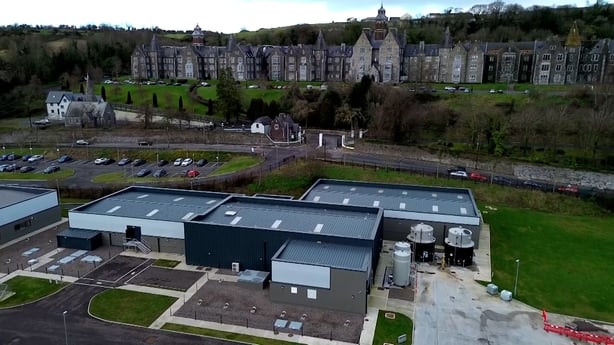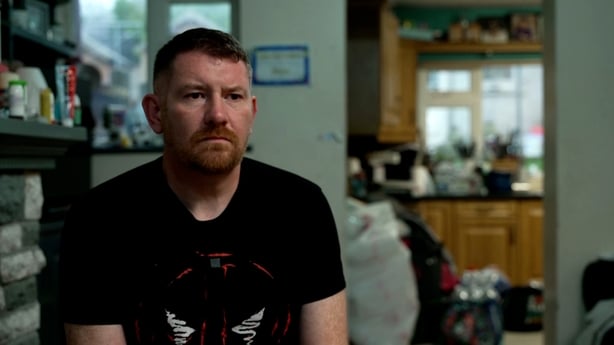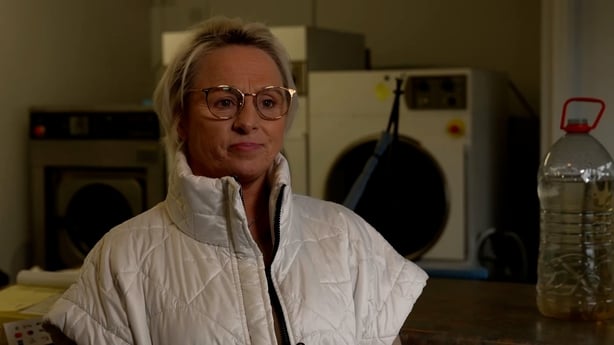Investigative tests carried out for Uisce Éireann (UÉ) on the water supply from the Lee Road drinking water treatment plant, which serves 70% of Cork city's households, found around a third of samples tested showed excessive manganese levels last year.
The test results held by the EPA and disclosed to Prime Time were conducted between May 2024 and January 2025 for Uisce Éireann by an independent laboratory.
Of a total of 246 water samples, 166 were tested for manganese. Of these, 58 samples were non-compliant, and 23 samples were at a level which the Health Service Executive (HSE) states "can be a risk to health" if consumed on an ongoing basis.
Uisce Éireann said it has repeatedly told users in the city not to drink water when it appears brown or discoloured and to "let it run for 20 minutes until it goes clear."
High levels of manganese are generally visible above regulatory limits.
No public health warnings have been deemed necessary.
UÉ has been sharing the results of its investigative testing with both the HSE and the Environmental Protection Agency (EPA), the regulator of water quality.
"Each non-compliance is risk assessed. It is agreed in consultation with the HSE whether consumers are required to be notified," UÉ said.
In response to queries from Prime Time, the HSE said that after meeting with UÉ on four occasions between September and November last year, "UÉ was advised by the HSE to inform the public in any location where manganese levels were above 80 µg/l [80 micrograms per litre] on an ongoing basis."
The HSE states that this should be "in addition to the advice UÉ was issuing in relation to what householders could do with regard to household water flushing."
The HSE says that it "understands from UÉ, that UÉ does not consider the population on the Cork North City supply to be exposed to Manganese levels above 80 μg/l on an ongoing basis, based on monitoring results."
It appears that the HSE and UÉ does not consider excessive levels of manganese are present in the water an "ongoing basis."
The data shows that, at times, the manganese levels remained high for days.
On 27 August, manganese in the supply at the Lee Road plant was at 192 µg/l - almost four times the permitted level. The following day it was at 182 µg/l. Three days later, on 30 August, it remained very high, both at the plant at 113µg/l, and in three household taps tested, which were 172 µg/l, 121 µg/l and 121 µg/l.
Another test result from a residential tap taken on 22 October showed manganese at 35 times the acceptable level at 1750 µg/l.
The HSE says "many years of exposure to high levels of manganese may have a harmful effect on the nervous system and brain development."
Other vulnerable groups include the elderly and people with liver disease or anaemia.
Uisce Éireann says just last month it fitted "an additional process at the plant [to] enhance the removal of manganese" from the raw water at Lee Road Treatment Plant.
This cost €1.6 in addition to the €40m upgrade of the plant in 2022.

Professor of DCU Water Institute Fiona Regan told Prime Time however that the public should be told about the manganese breaches.
"The regulations are there for a purpose. If you have significant breaches of that data, the public needs to know about it," she said.
"In general, manganese does not have health effects when it's within the limits set out by the regulations. However, the HSE state that above 80 micrograms per litre, it can have an effect on, for example, infants. And so therefore, where we see levels above 80, sometimes above 150, this is a concern in relation to public health."
When asked by Prime Time why Uisce Éireann’s webpage on drinking water quality showed 100% compliance in Cork city last year, including with five manganese tests results below 50 µg/l, UÉ said: "in addition to the regulatory monitoring we publish, tests are carried out as part of our ongoing investigative monitoring. These results are not published to our website."
'Stressful and worrying’
Steffen Liebig who lives with his wife Jennfier Malone and infant son Gabriel in the Sundays Well in the north of Cork city, says he is concerned about the breaches in water standards.
"I'm just baffled that this is possible. I'm being assured that the water that leaves the facility is continuously under observation, and it is compliant with all the required standards. Then, you're finding out that it's not all of a sudden, but you've been using it."
Eighteen months ago, shortly after Gabriel was born, Mr Liebig began contacting Uisce Éireann and other bodies such as the EPA, trying to find out when the persistent problem of brown tap water would be resolved.
Ms Malone says dealing with poor water quality when feeding a young child is "stressful and worrying".
She often leaves her house for the day when the water runs brown and spends it at her Dad’s who has clean water, across the city.
She also finds the lack of information is frustrating. "It's not knowing exactly what the issue is. We used a lot of bottled water. But then there's questions around microplastics and bottled water. So, which was worse?" say Jennifer.
Ten minutes away in Mount Farran on the northside, Dan O’Shea who lives with his wife and four sons says persistent problems with discoloured water means they have given up drinking tap water completely.
"We don't use the water from the tap. We just use bottled water for brushing our teeth, for drinking, because you just can't trust it."

Nine-year-old Adam, Dan’s youngest son, says he misses not being able to drink from the tap and taking baths. He hates the shower but has to take one "as the bath is too brown."
Dan says even flushing the toilet means the mains brings sludgy brown into his water tank, making it look "like something from Charlie and the Chocolate Factory."
Dan, who’s the family’s primary carer, say his daily routine is often set back as he can wait up to nine hours to get clear water to switch on the washing machine and generally clean up.
"Some mornings I might not go to bed till it happens 2, 3 o'clock, by the time you clean up and get ready for the following day. "
Stacks of bottled water not only clutter his home but take up a huge chunk of his carer’s allowance, the family’s main income, typically spending €17 every couple of days on bottled water.
Pamela O’Keeffe who runs Pam’s Laundrette in Gurranabraher says the problem with the brown water is destroying her business.
She recently lost a contract with a hotel after brown water entered her machines and discoloured the hotel’s sheets, which she then had to spend hundreds of euro to replace.
"They were destroyed. I couldn't get them back to what they should have been".
"It’s got to the stage now where I don’t know what to do," Ms O’Keeffe told Prime Time.
She often works late nights and weekends doing her washing in her domestic machine where there is no discoloration problem.
"I'm paying for water rates for dirty water. It's soul destroying."

The origin of the problem
The problem of Cork’s brown water has been an issue for nearly two-and-a-half years.
It began when the city’s main water treatment plant, on the Lee Road, was upgraded in July 2022. While the new plant was needed to eliminate e-coli problems, its treatment process interacted badly with the city’s roughly 300km of cast iron pipes, dating to the 1920s.
It affects pockets across Cork city, mainly on the northside but some in the south, notably Douglas, which is in Taoiseach Micheál Martin’s constituency.
Issues have been repeatedly raised at Cork City Council level, and in the Dáil by Sinn Féin TD Thomas Gould and outgoing TD People-Before-Profit Mick Barry, leading Uisce Éireann to set up a task force to deal with it.
Elaine Eager, from the Mount Farran Residents’ Association, which is an affected area, finds it "staggering" that effect of new water treatment process was not predicted. She met with UÉ last November who, she says, told her what happened.
"They went from a lime or an alkali type of solution to a more acidic one. The effect that that's had is that it has loosened all of this sediment in the cast iron pipes, sediment that's built up over decades."
An Uisce Éireann briefing to the EPA confirms this.
Prof Regan says what happened is "shocking and unacceptable."
"Particularly when talking about a new plant. You would imagine that enough time and study would have been carried out on the surface water supply to set the required operational conditions," she said.
Uisce Éireann says it has adjusted the chemical dosing in water treatment process to "minimise the effect" of pipe corrosion and will introduce a new conditioning process by mid-2025 to strengthen the old pipe network.
But it's not the only thing creating brown water.
Uisce Éireann’s general upgrading of supply network involving pipe repairs and a new pumping system are also creating pipes’ sediment issues which cause discolouration.
In addition, Uisce Éireann says it has a separate issue of fluctuating high manganese levels arising from changes in the source water, coming from the River Lee.
"The level of manganese in the raw water supplying the Lee Road [water treatment plant] is variable and increasing, as is the case nationally. There is a belief that climate change may be a contributory factor," according to Uisce Éireann.
Prof Regan thinks the response to these issues is too slow.
"All additions or modifications take time, but certainly the timelines there are very long. Especially when we're looking at a newly-commissioned, newly operating, plant that should be supplying water of consistent high quality. Certainly, the people deserve better."
Uisce Éireann’s says it is carrying out "targeted" and "proactive" flushing in parts of the city worst affected.
This means pumping water through district pipe networks and opening the water mains to let the sediment run off.
So far, it has flushed seven areas and plans seven more in 2025.
The long-term solution is to replace roughly 300km of the cast iron pipe network, at an estimated cost of roughly half a billion euro, which could take decades.
Elaine Eager says people like her want more immediate supports.
"Whether that be water tanks, vouchers for bottled water, and demand a plan for this proactive flushing, and make sure it happens."
Oonagh Smyth and Isabel Perceval's report covering water problems in Cork is covered on the 30 January edition of Prime Time, on RTÉ One television at 9.35pm.







